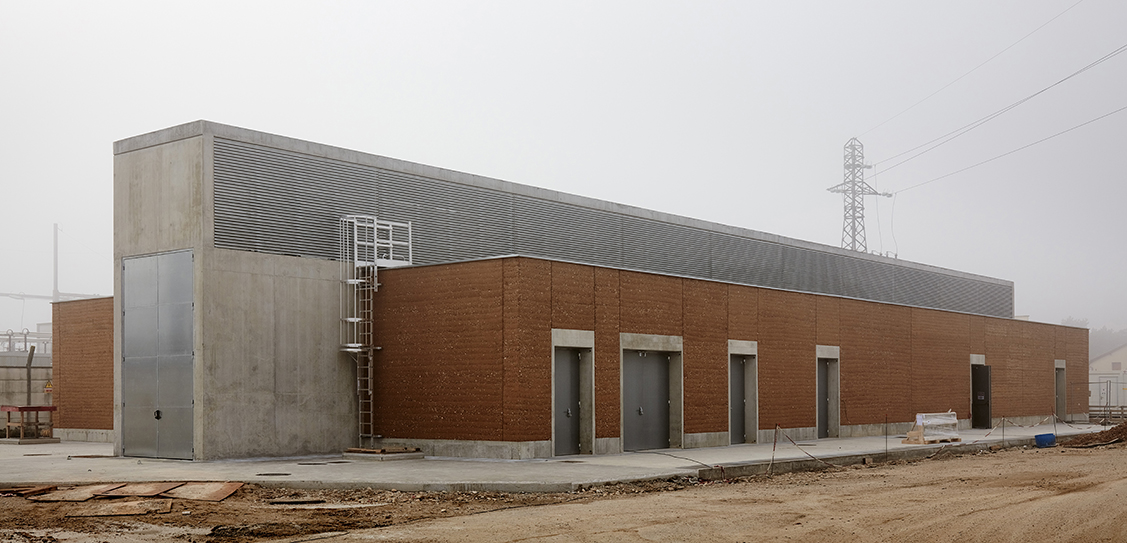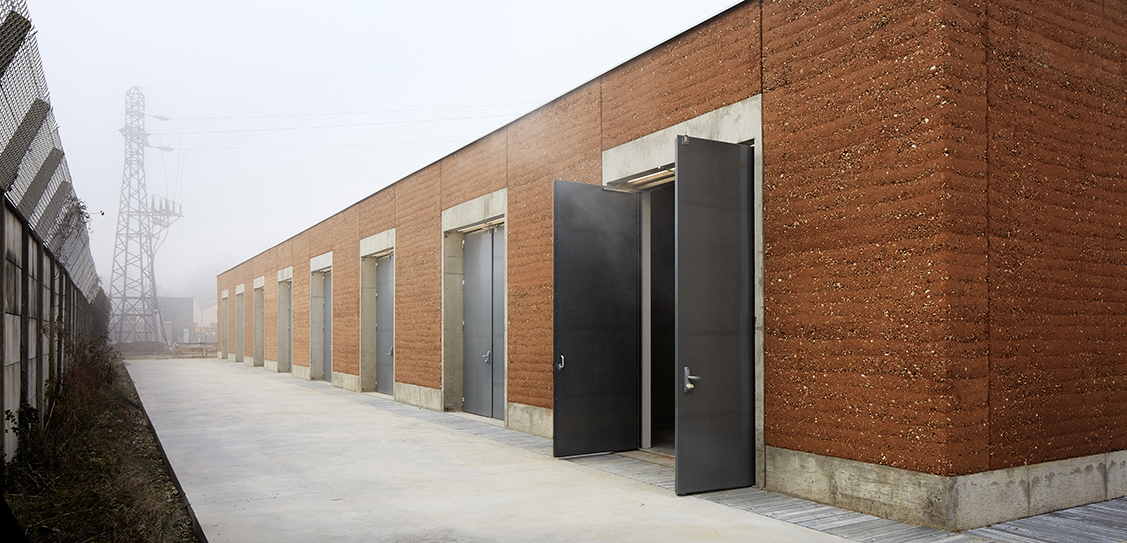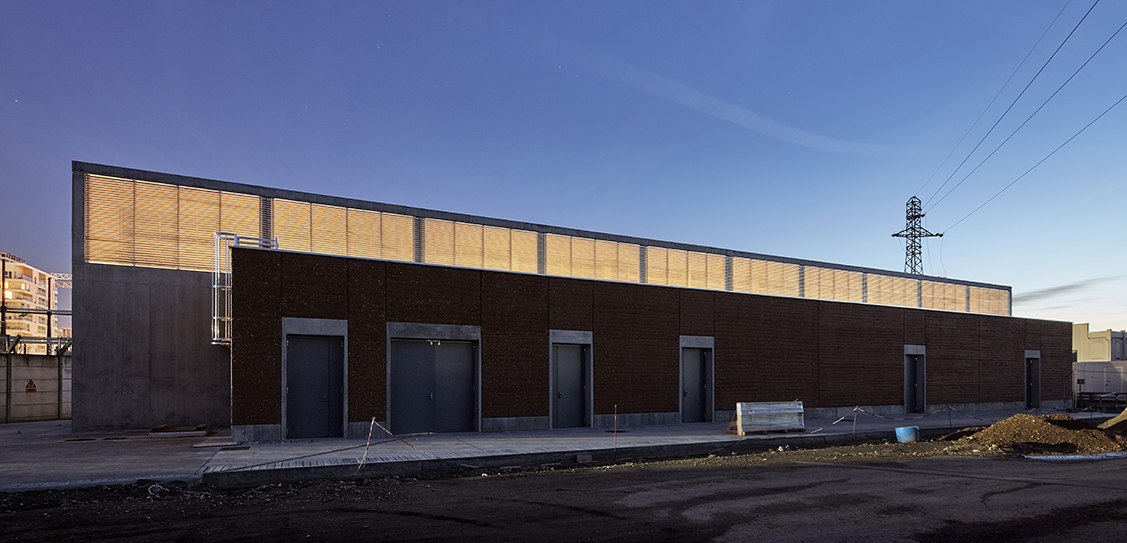The building is a purely technical structure which has to meet extremely strict standards, it is isolated on an industrial site and any human presence is rare. In the Cusset district of the city of Villeurbanne, this new substation is set against a very singular backdrop of overhead power lines, pylons, and industrial constructions built of concrete and galvanised steel. It is located next to the Jonage canal and the Cusset hydroelectric power station, a symbol of the city’s industrial development.
In parallel to the building of the substation, Tectoniques was also asked to construct a walkway to access the belvedere of the power station monument. Both the walkway and the substation assert themselves as industrial objects, deploying a certain economy of means. Whilst the first is a steel metal mesh beam which affords a certain transparency to the structure in front of the dam, the second is a robust, telluric structure made of concrete and earth which gives it a monumental feel in an otherwise unanchored site. In these settings of unexpected beauty, both structures avoid creating objects which are over-designed as everything is determined by the strict requirements of the industrial process.
The dimensions of the buildings are based on the size of the machines and their layout as set out in the very strict specifications, this means there was little room for manoeuvre regarding the form the project took.
The project is rooted in the earth; the rammed earth walls, associated with the concrete, express this grounding. Everything here comes from or returns to the earth. The deliberate simplicity of its industrial vocabulary allows it to meet the exacting technical requirements whilst developing a number of more delicate features, in search of a form of scholarly archaism.
Mainly housing plant rooms, the building is closed off, it is a robust structure, composed almost entirely of walls. These walls are a decisive feature of the structure and give it its materiality. The selected materials are raw, unflinching, two are already present on the site, concrete and galvanised steel. The earth is a new addition, offering a new language of expression. Its granular, softer texture, and warmer hue contrast with the smooth concrete. It does not stand out, but integrates a more rustic style. It complements the concrete which provides the structural support required. The exclusive use of these three materials embodies the industrial identity, aesthetic and stripped back.
The earth which is locally sourced, is employed using traditional techniques, compacted in successive layers. The earth walls were built by specialist tradespersons in conjunction with the association CRAterre for the studies and the BETerre engineering firm for the building work.
The resulting architecture is imposing, even monumental, far more so than the programme requires. It echoes the historic Cusset Hydroelectric Power Plant situated just a few hundred metres away on the Jonage Canal. The architects were inspired by the design and composition of the industrial buildings of the 19th century which embody the surrounding landscape.
The overall shape of the building is deliberately kept very simple; a central body made of raw concrete, flanked on either side by two additional wings built of earth. They are perforated by made-to-measure galvanised steel doors which provide access to the plant rooms on either side of the building. To the north, they are spaced out randomly, as required by the different facilities; to the south they follow a regular pattern which accentuates the monumental nature of the project. They are outlined by a concrete frame, with an exaggerated lintel of the same height as the base at 40cm, used to house the lighting and contrast with the feigned finesse of the abutments.
The galvanised steel components, doors, locks, sunshades, safety loops, crowns and outside lighting completes this deliberately limited pallet of materials; a duct made of steel sections runs around the building, outlining its limits. Here, all the metal equipment is grounded with copper plates which highlight the contours of the space.
The external atmosphere on the site is purely industrial; rows of pylons, overhead catenary system, the crackling of overhead power lines, sand, gravel and concrete walls. The new substation fits into this landscape, like a mausoleum. It will soon be surrounded, at a distance of six metres, by a protected, entirely sealed perimeter wall made of concrete sheet piling.
In response to this context, which first appears to be rather abrupt, and to the constraints of the functional organisation, the designers decided to dilate the programme, beyond its strict technical limits by creating a large, raw concrete hall which forms the backbone of the substation.
This section is accessed via two large metal doors at each end, both standing five metres high. The very slender proportions of the interior space, 10m high and just three metres wide, create a spectacular sequence which sets the stage for the substation operations.
In the upper section, aluminium sunshades provide ventilation and let natural light into the building. At night, the interior lighting produces a long, enigmatic strip of light, in the sky of this vast industrial platform, like a magic lantern.
The semi-circular shafts between floors add a theatrical, baroque effect which enhances the very carefully produced raw concrete; functionally, these act as skylights. There are two large, straight staircases either end of the corridor which dictate the movements of people and cables, descending down into the ground in the basement.
In a raw concrete interior, every last detail serves the quality of the architecture, the layout of the ventilation shafts, the choice of vertical emergency power units, the interior barriers and doors made of galvanised steel, suspended light fittings in an industrial style. The space is enhanced and staged, and is a convincing example that architecture contributes to the well-being, beauty and pleasure of its users.



